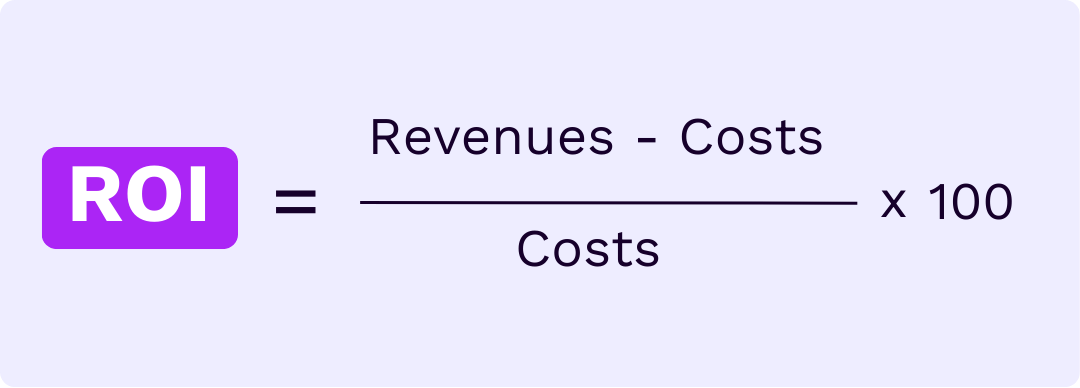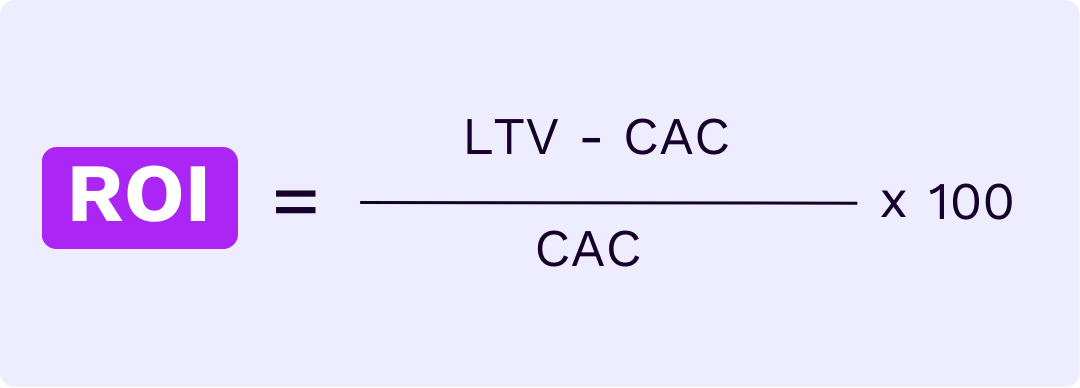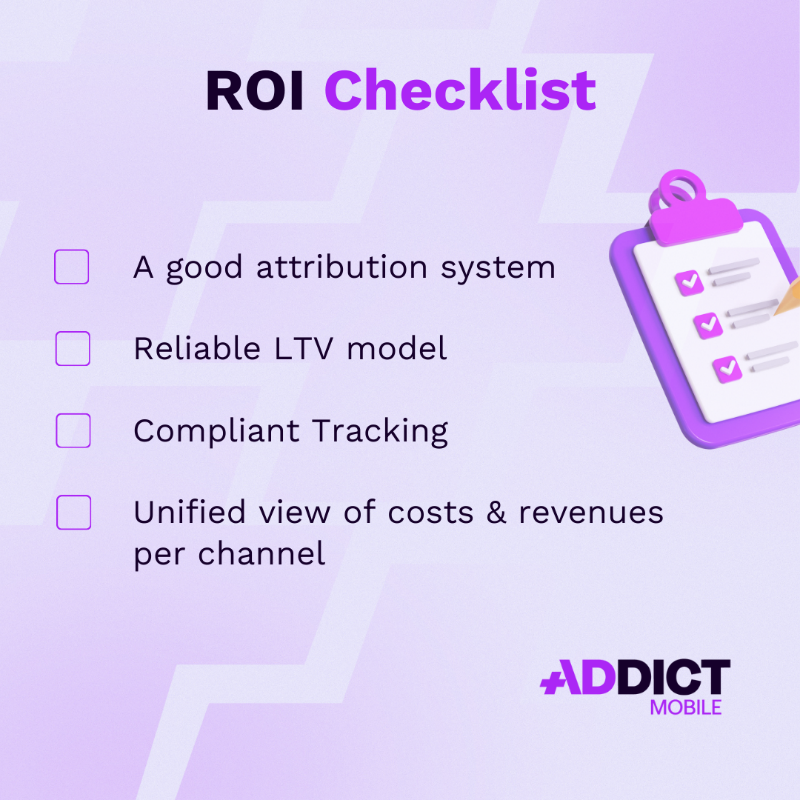Maximizing ROI in App Marketing: Calculation, Challenges, and Best Practices
Introduction
Return on Investment (ROI) is an essential metric in mobile marketing. It helps assess the profitability of acquisition campaigns and optimize budget allocation. Understanding how to calculate and improve ROI is crucial for marketers. This article explores in detail how to calculate ROI, why it matters, the challenges it presents, and the best practices to improve it.
What Is ROI?
Definition
ROI (Return on Investment) is a financial metric that measures the profitability of an investment. It is used to determine whether the expenses incurred in a marketing campaign generate revenue that exceeds costs. In app marketing, it is a key tool for evaluating whether an acquisition strategy is effective or needs adjustment.
Calculation Methods
There are two main methods to calculate Return On Investment:
- Classic Formula:

This general formula is used across all sectors to measure investment performance.Cette formule générale est utilisée dans tous les secteurs pour mesurer la performance d’un investissement.
2. Mobile Marketing Adapted Formula:

This version factors in the long-term value of an acquired user, which is crucial in app marketing where retention and engagement greatly impact profitability.
ROI vs ROAS
Return On Investment and ROAS (Return on Ad Spend) are often confused.
- ROAS measures revenue generated solely against ad spend.
- ROI includes all costs (production, management, acquisition, etc.), offering a broader view of profitability.
Why Is ROI Essential in App Marketing?
Return On Investment is a widely used metric in app marketing because it helps optimize budgets by prioritizing the most profitable channels. ROI answers several strategic questions:
Measuring Campaign Performance
Return On Investment is the most reliable indicator to determine if an acquisition campaign is profitable. It enables marketers to compare different investments and justify marketing expenses.
Identifying the Most Effective Channels and Campaigns
Analyzing Return On Investment by channel (Facebook Ads, Google Ads, TikTok Ads, etc.) helps identify the most valuable sources and focus budgets accordingly.
Optimizing Marketing Budgets
Regular monitoring of ROI allows for reallocating budgets toward the most profitable campaigns and adjusting strategies based on performance.
Improving Acquisition and Retention Strategies
ROI doesn’t stop at acquisition—it also impacts user retention and engagement. A good strategy aims to extend user LTV to maximize profitability.
Managing Rising Costs
With acquisition costs (CAC) increasing, maximizing Return On Investment is a strategic priority to ensure advertising investments remain profitable.
Aligning Acquisition With Retention
A sound ROI strategy considers both acquisition and the long-term value of users (LTV), including retention efforts, to maximize overall profitability. Analyzing ROI also supports retargeting strategies.
What Are the Challenges of Measuring ROI?
Calculating ROI in app marketing can be complex due to several factors:
Multi-Touch Attribution
Users often interact with multiple channels before installing the app (social media, ads, word-of-mouth, influencers…). It’s difficult to credit the right channel. Using an MMP brings more impartiality compared to relying solely on platform-reported results.
Limited Tracking (Especially on iOS)
Since iOS 14.5, Apple has restricted user tracking via the ATT (App Tracking Transparency) framework. This has led to data loss, less reliable attribution, and weaker feedback from platforms like Meta and Google.
Variable Acquisition Costs (CAC)
Cost per install (CPI) or per active user varies by time, region, platform, etc. This makes clear ROI evaluation hard without granular segmentation.
Uncertain User Lifetime Value (LTV)
LTV is often estimated using historical behavior, but usage may differ across cohorts. If monetization depends on subscriptions or in-app purchases, value may only appear over the long term.
Hard-to-Measure Indirect Impact
Brand awareness, word-of-mouth, and branding efforts contribute to success but don’t generate immediate returns. These effects are not easily factored into traditional ROI calculations.
Data Fragmentation
Data is often scattered across tools:
- Ad Platforms: Google Ads, Meta Ads, Firebase,
- MMPs: Appsflyer, Adjust.
- DSPs: Remerge, Unity Ads, IronSource, AppLovin
Marketers must centralize, clean, and model data to get a coherent view of ROI.
ROI ≠ Immediate Profitability
A high ROI can mask poor short-term profitability if revenues take time to materialize. A clear view may only emerge after several months.
👉 In Short:
Calculating ROI in app marketing requires:

Other Complementary KPIs
- ROAS: For analyzing ad-specific returns
- LTV: For estimating long-term user value
- CPA: To measure acquisition cost per user
- Retention rate: To evaluate user loyalty
- ARPU: To track average revenue per user

Do not hesitate to contact with our teams
Addict can support you to improve your performance.
Best Practices to Increase ROI in App Marketing
Improving Return On Investment long term requires both cost optimization and increasing the value generated per user. Below are key best practices, categorized by theme:
User Acquisition Optimization (UA)
- Smart targeting: Use lookalike audiences and custom segments (e.g., past purchasers) to increase ROI. Test different regions or geos with favorable CPI/LTV ratios.
- Testing & iteration: A/B test creatives, messaging, and CTAs to find top-performing ad sets. Pause unprofitable campaigns/channels quickly.
- Use MMP tools: MMPs are essential for better attribution and per-channel profitability tracking. Learn more about how to choose your MMP here.
Improve Onboarding and Retention
- Smooth, engaging onboarding: The user experience must demonstrate app value quickly and guide users toward a key action (first purchase, sign-up, etc.).
- Well-crafted push notifications & emails: Re-engage inactive users with personalized messaging. Behavioral triggers (e.g., abandoned cart, inactivity) automate processes.
- Cohort analysis: Study user behavior by acquisition date or source to refine the app and marketing strategy.
Maximize Monetization
- Optimize ARPU: Test different monetization models like freemium, subscription, in-app purchases, or ads. Use smart paywalls and tailored offers.
- Upsell and cross-sell: Offer bundles, premium features, or bonuses to active users when appropriate.
- Localization/personalization: Adapt your app (language, offers, content) to local markets to boost conversion and loyalty.
Tracking, Data, and Continuous Optimization
- Measure LTV by channel and cohort: Know how much to spend per user without wasting budget.
- Implement continuous experimentation: Test new creatives, push messages, pricing models, etc.
- Clear dashboards = clear insights: Aggregate acquisition, usage, and revenue data into clean dashboards to continuously monitor true return on investment.
Build a Long-Term Brand
Strong branding improves retention and reduces CAC over time. An engaged community (social media, Discord, ambassadors) can generate word-of-mouth with no added cost.
Conclusion
ROI is a key metric in app marketing. Understanding how to calculate it, overcoming its challenges, and applying best practices helps optimize investments and improve campaign profitability.


